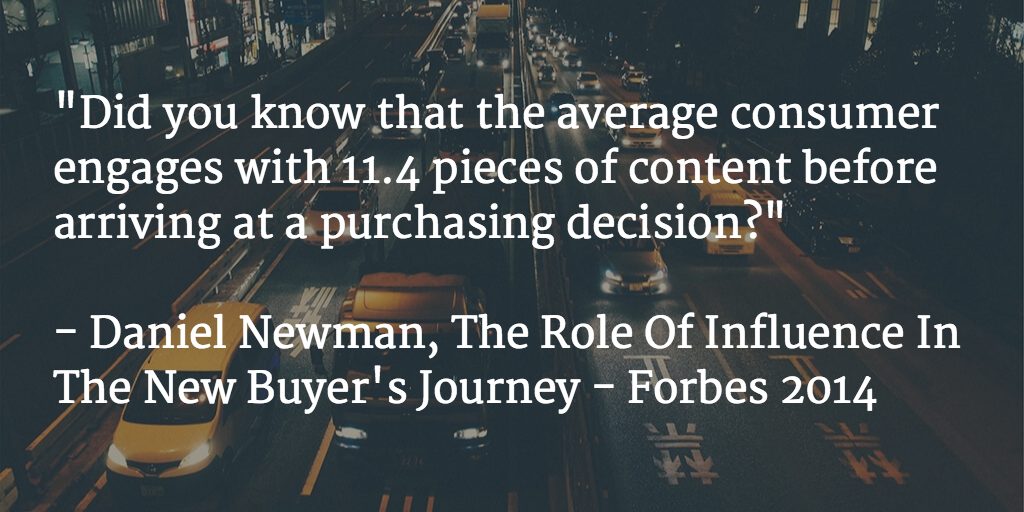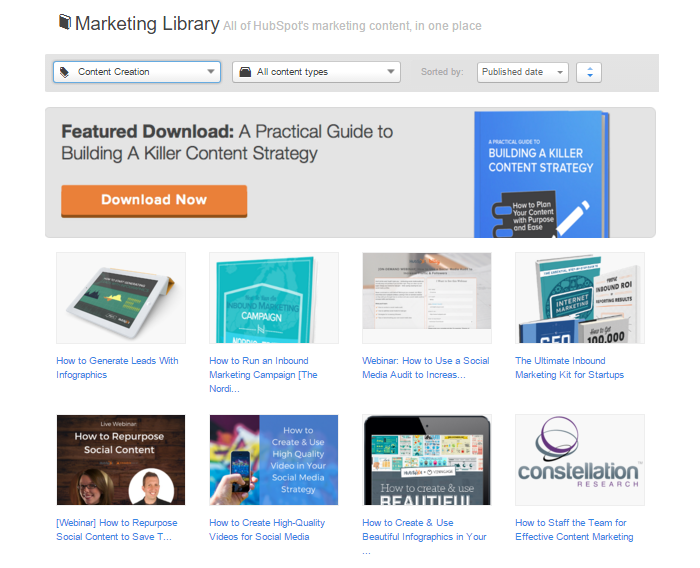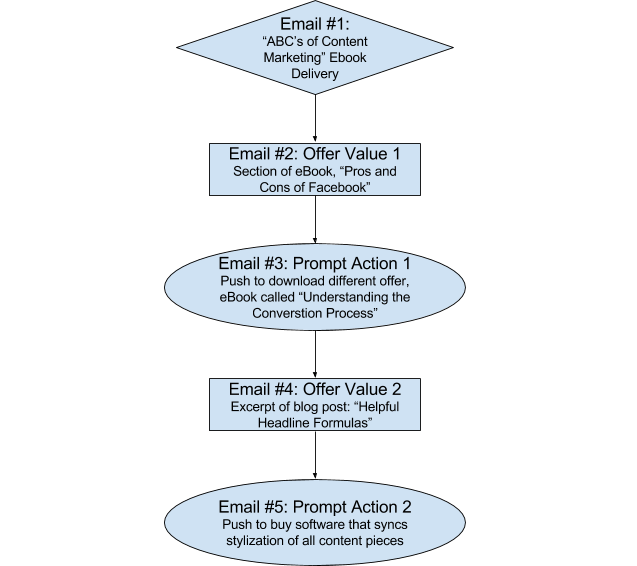How to Create Dozens of Content Campaigns from One eBook
Life changing news flash: thin is out, fat is in.
Well, at least in terms of content.
Jesse Noyes, senior director of content marketing for Kapost, says that due to some Google algorithm updates, content marketing efforts are becoming–and will continue to be–all about “fat” content.
In other words, whitepapers, infographics, and eBooks are in, while “thin” content, like short, infrequent blog posts, are out.
The truth is, though the process of committing to longer-form content might seem daunting, this trend could not be more beneficial to content marketers. We always say quality over quantity, and that should always be your mantra, but long-form content is able to provide both.
Not only does the length and scope of such pieces provide a sizable boost of thought leadership, in other words helping establish your expertise and authority online through a consistent presence of valuable, relevant articles. But from a more tactile perspective, it takes a lot of fuel to keep the content marketing fire burning effectively, and “fat” content offers quite a lot of combustible material.
For example, take a single eBook.
Just one offer can become the foundation for dozens of pieces of content for campaigns across various channels.

Here’s how to transform your eBook into multiple content wins:
Reformat Content to Repurpose It
While a library full of eBooks is indeed becoming a more valuable asset for thought leadership and online marketing efforts, in general, a strong content marketing strategy will always stand on consistent and relevant blog posts.

To continue to build up this foundation of engaging articles, break down the substantial content you’ve already published–in this case, your eBook.
Repurposing premium offers like eBooks into stand-alone content like blog posts and articles is the easiest and most time-efficient way to drive traffic to your site.
All you need to do is take a look at your table of contents.
You’ve already broken down the eBook into individual topics, and they’re visible at a glance on page one. Each chapter title can be a blog post title or the chapters themselves can be broken up into individual posts based on their subheadings.
Here’s an example of how it would look:
You write an eBook called The ABC’s of Content Marketing. The chapters include:
– The importance of building up thought leadership
– Components that make up an efficient blog post
– Content distribution: getting the word out
You could write a blog post about each of those topics, or expand your reach and break them down further.
Turn the thought leadership chapter into three individual articles:
– The importance of utilizing industry research and news to become an informed and authoritative voice in the sphere
– How distributing content in the right places can be just as important for building thought leadership as creating that content
– Why understanding customer’s questions will do more for your thought leadership than relying on keyword ranking opportunities
Now on to the components of efficient blog posts. There are at least three posts there:
– What every blog post needs–besides strong content
– Where and how to optimize your blog post to the max
– What makes compelling blog content
And let’s get three more from content distribution:
– The pros and cons of each major social media channel for promoting your company’s blog posts
– The importance of ‘digital PR’ and having your blog posts be featured elsewhere
– How to get the most out of your Linkedin profile when distributing content
So from just three chapters in one eBook, we’ve extracted 9 separate blog titles. And no doubt, with a little creativity, you can come up with several more blog titles for each chapter.
Remember: coming up with these topics doesn’t have to be an extended brainstorm process of understanding what topics relate to the overarching theme of your eBook.
These are all topics that have already been addressed, as sections of the larger chapters in the book. You are simply extracting sub-headers, and making them articles in their own right.
Of course, not only do you have the topics, but you also have the text to go with each title.
I wouldn’t recommend just copying and pasting the respective chapter into its own blog post–you may need to rework it a bit for flow and readability. You also need to ensure that the post is highlighting the specific topic well and isn’t missing any exposition that may have come earlier in your eBook.
Perhaps even adjust the title slightly so that readers feel as though they are getting something truly unique.
The research, heavy writing, and organization of the topic–you did all that when you wrote the eBook, which makes this part of the process much easier.
The benefits of repurposing content into your blog posts are clear. You can make the most of the immense efforts you put into creating an eBook by:
– Creating multiple new opportunities for thought leadership from just one piece
– Reaching a wider audience by narrowing down on topics that may appeal to one persona over another
– Promoting the original offer with calls-to-action included on the bottom of each blog post
Of course, a blog isn’t the only channel ripe for repurposing content.
Instead of, or really in addition to, breaking your eBook into written content, you can turn it into an audio podcast series.

Further, you can create an engaging infographic to convey the information you’ve included in your eBook, but in a slightly more sharable medium. According to a Demand Gen Report, 39% of B2B buyers identified that they share infographics on social media frequently.
Always think through what additional formats and mediums would be a good fit for the content in your eBook, and more specifically, how effective it will be to the target audience you wish to reach with it.
Email Engagement and Lead Nurturing
Email marketing is one of the most efficient ways to nurture and delight your customers long term. Since you’ve already created ‘delight-ful,’ valuable content in your eBook, there’s no better source to use for breaking it up.
There are several ways to repurpose your eBook into a strong email marketing strategy that captures and converts leads.
To start, create an email workflow built around the delivery of the eBook.
While you’ll likely have the eBook available through a thank you page that greets a prospect after submitting their contact information, you should also have an automated email workflow ready to be activated as soon as that information is processed.
Not only will this workflow serve to deliver the eBook straight to their inbox for convenient access, but it can also offer additional relevant content that will keep readers engaged longer-term, and encourage them to convert to your sales objective. It’s, therefore, worth building a strategy that hits both goals.
You can follow up your eBook delivery email with one that offers some sort of additional value, sort of like an abridged blog post on a topic relevant to the eBook.
Offering value is continuing to educate through more relevant content. The prospect isn’t expected to do anything other than read and enjoy an interesting piece of content.
For example, you can cut a paragraph from one of the blog posts you’ve created from the eBook chapters, include it as an excerpt in your email, and then link back to the blog post if they want to learn more.
Mix and match the emails in the workflow schedule to provide a balance of offering value and prompting action. Prompting action takes a more aggressive stance than simply offering value, by asking readers to take a step that will move them down the sales funnel.
Examples would be encouraging them to purchase a product, download another offer, follow you on social media, etc.

This is an email workflow that will engage your customers and nurture them until they’re ready to take further action with you.
Your single eBook can fuel this entire process, not only by providing the actual content for half of the emails you’re sending, but also for providing the initial catalyst for interacting with the lead in the first place.
This isn’t the only type of workflow you can generate from your eBook for email marketing purposes.
If you’ve written a how-to eBook, consider turning it into an instructional email course. Or create an engaging email newsletter made up of various components of the eBook.
However you go about it, email is a prime platform to not only get more eyes on your eBook but to further capitalize on its contents while allowing you to engage customers and nurture them long-term.
Fueling the Future
We’ve discussed how pieces of your eBook can be repurposed as individual blog posts. But an eBook can also serve to inspire longer-term content creation. It can serve as a brainstorm starting point, generating further relevant content on a topic that was proven successful as an offer.
For example, let’s say you write a well-received eBook on the importance of LinkedIn for generating leads. If it performs well, you might consider having your next offer be a case study about a client who was particularly effective with LinkedIn.
This isn’t just about taking content from what already exists; it’s about creating new content based on what’s been proven effective. In other words, an eBook will serve to provide critical information about what is and what is not being well received by your prospects.
This is where data analysis is going to come in.
You’ll want to understand the reaction to the eBook, to really grasp what works and what doesn’t.
Some key metrics to consider include:
The click-through rate on the CTAs promoting the eBook. The CTA is directly conveying what’s to come in the eBook, so if people aren’t clicking through to it, it’s likely because they’re not interested in the topic. That, or you haven’t effectively communicated its value proposition.
Also, pay attention to the source of those CTAs, especially if you’ve included them on blog posts that have been broken away from the eBook. It will give you an idea of which specific subtopics resonate more.
The submission rate on the host landing page. If users are clicking through to the landing page but not submitting the form to download the eBook, it’s possible that the overarching theme of the eBook piqued their interest, but the details elaborated on the landing page didn’t do it justice.
It might, therefore, be worth considering how to rework the topic, perhaps present a different angle that’s more appealing.
A poor submission rate could also be a reflection of the form length or the layout of the landing page, so test those elements by making incremental changes before you rule out the project completely.
Any social media conversation about the piece. When you promoted the book on social media, did people click through or engage with it? Were there any extensive discussions on posts you put out relating to the eBook topic?
See what your audience is saying about the piece to understand how they feel about it.
The conversion rate on the email workflow built around the eBook. This is again a prime opportunity to see which topics are resonating and which less so, as the email content will be taken straight from the eBook itself.
See if readers are motivated to click through to the blog posts about the eBook and learn more about the topic, or if their engagement ends after the first message.
You could even survey recipients for direct feedback to help accurately paint a picture of the eBook’s success or failure.
By taking a deep dive into how a certain eBook topic is resonating with your audience, you can better understand what content you should be creating down the line, thus continuing to provide value to your audience through topics you know interest them.
Conclusion
Every piece of text you share with your audience is contributing to their perception of you as a thought leader, and their engagement with your company long-term.
Long-form content perhaps achieves the most in that regard, as you demonstrate your confidence in producing such an extensive look at a given topic
But don’t stop there.
By using one eBook to generate and enhance multiple facets of your marketing efforts, such as blog posts, email campaigns, conversion opportunities, and future ideas, you can ensure that your ‘fat’ content will fatten up your marketing results long-term.













